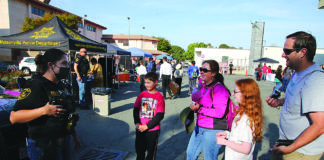At midnight, it became official: California is open.
Of course, the coronavirus pandemic isn’t over, and life isn’t back to the way it was before most of us had heard of the mysterious, deadly illness we now call Covid-19.
But the lifting of nearly all of the state’s remaining pandemic restrictions is a significant emotional and psychological milestone for residents of a state that has experienced some of the nation’s most enduring lockdowns.
As my colleagues and I reported, the reactions to Tuesday’s reopening have varied widely, from outright jubilation to continued frustration with Gov. Gavin Newsom for keeping orders in place for so long.
For many Californians, not much may change. Workers will still have to wear masks, even if they’re vaccinated, for at least part of this week.
Still, Californians have survived a lot in the past year and a half — and that’s to say nothing of the wildfires, smoke-filled skies, heat, drought and other disasters that have befallen our state while the coronavirus has ravaged communities.
To give a little perspective, here’s a short timeline of the coronavirus pandemic in California:
— Jan. 29, 2020: The U.S. government imposes a two-week quarantine on 195 people evacuated from Wuhan, China, to March Air Reserve Base in Riverside County. It is a rare step.
— March 9, 2020: The Grand Princess cruise ship, which was stranded off the coast of California with coronavirus cases on board, docks at the Port of Oakland. It’s a floating symbol of America’s fear of the virus.
— March 13, 2020: The state’s four largest school districts — Los Angeles Unified, San Diego Unified, Fresno Unified and Long Beach Unified — announce they’ll close classrooms, as health officials in Los Angeles confirm eight more coronavirus cases in the county. District officials expect the closures to last weeks.
— March 19, 2020: Gov. Gavin Newsom orders all 40 million Californians to stay at home as much as possible, not only starting one of the largest-scale public health experiments in memory, but also raising difficult questions about what it means to do essential work.
— April 28, 2020: Newsom unveils the state’s first phased reopening timeline. The plan doesn’t include specific dates but sets metrics that officials will track.
— June 18, 2020: The governor makes face coverings mandatory after local mandates faced pushback.
— July 1, 2020: An alarming surge in cases prompts the state to order bars and indoor dining to close in the state’s hardest-hit counties. It’s the most significant rollback yet of the state’s halting efforts to reopen.
— Aug. 28, 2020: Newsom unveils the state’s color-coded tier system for reopening. It will be the last framework for imposing and easing restrictions county by county.
— Nov. 12, 2020: California becomes the second state after Texas to reach 1 million known coronavirus cases.
— Dec. 3, 2020: Amid another surge in cases — the most terrifying California has experienced, because hospitals are overwhelmed — the state imposes new, stringent stay-at-home orders on a regional basis, based on the capacity of intensive care units. Restaurants offering outdoor dining close again. Families brace for distanced holidays.
— Dec. 14, 2020: The first doses of coronavirus vaccine are administered in California. Helen Cordova, an intensive care nurse at Kaiser Permanente Los Angeles Medical Center, is the first person in California to get her shot.
— Feb. 24, 2021: California surpasses 50,000 known coronavirus deaths — becoming the first state to reach that bleak milestone. It’s still far from the hardest hit relative to the size of its population.
— April 15, 2021: All Californians age 16 and older become eligible for vaccines, as inoculations become more widely available.
— April 30, 2021: Disneyland reopens at 25% capacity.
— June 15, 2021: California reopens — without capacity restrictions or distancing requirements.











